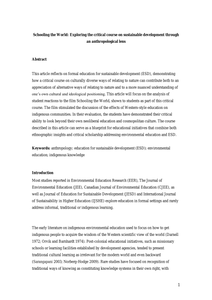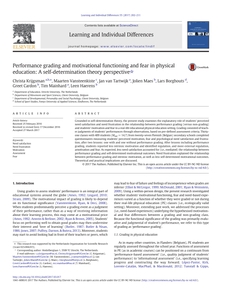Since the arrival of cinema, film theorists have studied how spectators perceive the representations that the medium offers to our senses. Early film theorists have bent their heads over what cinema is, how cinema can be seen as art, but also over what cinema is capable of. One of the earliest film theorists, Hugo Münsterberg argued in 1916 that the uniqueness of cinema, or as he calls it photoplay, lies in the way it offers the possibility to represent our mental perception and organisation of the reality, or the world we live in: “the photoplay tells us the human story by overcoming the forms of the outer world, namely, space, time, and causality, and by adjusting the events to the forms of the inner world, namely, attention, memory, imagination, and emotion” (Münsterberg [1916] 2004, 402)
LINK
When conducting research in and for the creative industries, there are a wealth of different possible research approaches that can be taken - reflecting the diverse nature of the disciplines (design, arts and crafts, advertising, architecture, fashion, film, music, TV, radio performing arts, publishing and interactive software) and academic contexts (art schools, business schools and universities) involved. The result is that there are variations in the emphasis and approach taken to how students are taught to link theory with practice, and how they view and engage with the concept ʻresearchʼ. The need for understanding and awareness of a range of approaches is critical for anyone learning about and working within design, business and the creative industries today.
DOCUMENT

This article will discuss the role of environmentalism in environmental education (EE) and education for sustainable development (ESD) in the context of ecopedagogy. Ecopedagogy calls for the remaking of capitalist practices and seeks to re-engage democracy to include multispecies interests in the face of our current global ecological crisis. In this article, the written reports by international business students on the documentary film If a Tree Falls about a radical environmental movement will be discussed. The aim of this article is to reflect upon the question of whether confrontational questions posed by radical environmentalism can move students to re-examine certain central assumptions within their own society and education. The analysis of students’ individual writing assignments after viewing the film is placed in the context of the discussion about the aims of education in relation to environmental advocacy. This case study seeks to provide an example of how environmental advocacy and the objective of pluralistic education can be combined as mutually supportive means of achieving both democratic learning and learning for environmental sustainability. https://doi.org/10.1177/0973408215569119 https://www.linkedin.com/in/helenkopnina/
MULTIFILE

In spite of renewed attention for practices in tourism studies, the analysis of practices is often isolated from theories of practice. This theoretical paper identifies the main strands of practice theory and their relevance and application to tourism research, and develops a new approach to applying practice theory in the study of tourism participation. We propose a conceptual model of tourism practices based on the work of Collins (2004), which emphasises the role of rituals in generating emotional responses. This integrated approach can focus on individuals interacting in groups, as well as explaining why people join and leave specific practices. Charting the shifting of individuals between practices could help to illuminate the dynamics and complexity of tourism systems.
DOCUMENT

This article reflects on formal education for sustainable development (ESD), demonstrating how critical course on culturally diverse ways of relating to nature can contribute both to an appreciation of alternative ways of relating to nature and to a more nuanced understanding of one's own cultural and ideological positioning. This article will focus on the analysis of student reactions to the film Schooling the World, shown to students as part of this critical course. The film stimulated the discussion of the effects of Western-style education on indigenous communities. In their evaluation, the students have demonstrated their critical ability to look beyond their own neoliberal education and cosmopolitan culture. The course described in this article can serve as a blueprint for educational initiatives that combine both ethnographic insights and critical scholarship addressing environmental education and ESD. https://doi.org/10.1016/j.ijer.2013.10.002 https://www.linkedin.com/in/helenkopnina/
MULTIFILE

Environmental advocacy has a difficult position within environmental education (EE) and education for sustainable development (ESD). Proponents of pluralistic approaches to education see advocacy as a form of indoctrination. However, pluralistic education itself can be seen as a form of indoctrination. Its normative assumptions are based on the neo-liberal capitalist values that tend to view environmentalism as a threat to the established norms. In this paper I will argue that environmental advocacy is in fact essential for educating critical citizens capable of addressing sustainability challenges. This argument will be supported by the written reports on the documentary film about the radical environmental movement presented to the students of International Business Management Studies (IBMS) of The Hague University of Applied Science (HHS). This case study will provide an example of how environmental advocacy and the objective of pluralistic education can be reconciled and explore the advantages of combining business education with education for deep ecology. https://doi.org/10.1504/IJISD.2014.066621 https://www.linkedin.com/in/helenkopnina/
MULTIFILE

Sustainable consumption is interlinked with sustainable production. This chapter will introduce the closed-loop production, the circular economy, the steady state economy, and Cradle to Cradle (C2C) models of production. It will reflect on the key blockages to a meaningful sustainable production and how these could be overcome, particularly in the context of business education. The case study of the course for bachelor’s students within International Business Management Studies (IBMS) program at three Universities of Applied Science (vocational schools), and at Leiden University College in The Netherlands will be discussed. Student teams from these schools were given the assignment to make a business plan for a selected sponsor company in order to advise them how to make a transition from a linear to circular economy model. These case studies will illustrate the opportunities as well as potential pitfalls of the closed loop production models. The results of case studies’ analysis show that there was a mismatch between expectations of the sponsor companies and those of students on the one hand and a mismatch between theory and practice on the other hand. The former mismatch is explained by the fact that the sponsor companies have experienced a number of practical constraints when confronted with the need for the radical overhaul of established practices within the entire supply chain and students have rarely considered the financial viability of the "ideal scenarios" of linear-circular transitions. The latter mismatch applies to what students had learned about macro-economic theory and the application through micro-economic scenarios in small companies. https://www.springer.com/gp/book/9783319656076 LinkedIn: https://www.linkedin.com/in/helenkopnina/
MULTIFILE

Grounded in self-determination theory, the present study examines the explanatory role of students' perceived need satisfaction and need frustration in the relationship between performance grading (versus non-grading) and students' motivation and fear in a real-life educational physical education setting. Grading consisted of teacher judgments of students' performances through observations, based on pre-defined assessment criteria. Thirty-one classes with 409 students (Mage = 14.7) from twenty-seven Flemish (Belgian) secondary schools completed questionnaires measuring students' perceived motivation, fear and psychological need satisfaction and frustration, after two lessons: one with and one without performance grading. After lessons including performance grading, students reported less intrinsic motivation and identified regulation, and more external regulation, amotivation and fear. As expected, less need satisfaction accounted for (i.e., mediated) the relationship between performance grading and self-determined motivational outcomes. Need frustration explained the relationship between performance grading and intrinsic motivation, as well as less self-determined motivational outcomes. Theoretical and practical implications are discussed.
DOCUMENT

Movement is an essential part of our lives. Throughout our lifetime, we acquire many different motor skills that are necessary to take care of ourselves (e.g., eating, dressing), to work (e.g., typing, using tools, care for others) and to pursue our hobbies (e.g., running, dancing, painting). However, as a consequence of aging, trauma or chronic disease, motor skills may deteriorate or become “lost”. Learning, relearning, and improving motor skills may then be essential to maintain or regain independence. There are many different ways in which the process of learning a motor skill can be shaped in practice. The conceptual basis for this thesis was the broad distinction between implicit and explicit forms of motor learning. Physiotherapists and occupational therapists are specialized to provide therapy that is tailored to facilitate the process of motor learning of patients with a wide range of pathologies. In addition to motor impairments, patients suffering from neurological disorders often also experience problems with cognition and communication. These problems may hinder the process of learning at a didactic level, and make motor learning especially challenging for those with neurological disorders. This thesis focused on the theory and application of motor learning during rehabilitation of patients with neurological disorders. The overall aim of this thesis was to provide therapists in neurological rehabilitation with knowledge and tools to support the justified and tailored use of motor learning in daily clinical practice. The thesis is divided into two parts. The aim of the first part (Chapters 2‐5) was to develop a theoretical basis to apply motor learning in clinical practice, using the implicit‐explicit distinction as a conceptual basis. Results of this first part were used to develop a framework for the application of motor learning within neurological rehabilitation (Chapter 6). Afterwards, in the second part, strategies identified in first part were tested for feasibility and potential effects in people with stroke (Chapters 7 and 8). Chapters 5-8 are non-final versions of an article published in final form in: Chapter 5: Kleynen M, Moser A, Haarsma FA, Beurskens AJ, Braun SM. Physiotherapists use a great variety of motor learning options in neurological rehabilitation, from which they choose through an iterative process: a retrospective think-aloud study. Disabil Rehabil. 2017 Aug;39(17):1729-1737. doi: 10.1080/09638288.2016.1207111. Chapter 6: Kleynen M, Beurskens A, Olijve H, Kamphuis J, Braun S. Application of motor learning in neurorehabilitation: a framework for health-care professionals. Physiother Theory Pract. 2018 Jun 19:1-20. doi: 10.1080/09593985.2018.1483987 Chapter 7: Kleynen M, Wilson MR, Jie LJ, te Lintel Hekkert F, Goodwin VA, Braun SM. Exploring the utility of analogies in motor learning after stroke: a feasibility study. Int J Rehabil Res. 2014 Sep;37(3):277-80. doi: 10.1097/MRR.0000000000000058. Chapter 8: Kleynen M, Jie LJ, Theunissen K, Rasquin SM, Masters RS, Meijer K, Beurskens AJ, Braun SM. The immediate influence of implicit motor learning strategies on spatiotemporal gait parameters in stroke patients: a randomized within-subjects design. Clin Rehabil. 2019 Apr;33(4):619-630. doi: 10.1177/0269215518816359.
DOCUMENT

Background: Sexual deviance is regarded as an important risk factor for sexual offending. However, little is known about the development of deviant sexual interests. The transfer of arousal between emotions, i.e., excitation transfer, could attribute sexual salience to stimuli that would otherwise not be sexual in nature. As such, excitation transfer could contribute to the very beginning of unusual or deviant sexual interests. The current protocol proposes a study to investigate to what extent excitation transfer occurs, i.e., to what extent genital and subjective sexual arousal to sexual stimuli is higher in an emotional state than in a neutral state. Following a prior pilot study, several adjustments were made to the study protocol, including a stronger emotional manipulation by using 360-degree film clips and the inclusion of a larger and more sexually diverse sample. Methods: We will recruit 50 adult male volunteers with diverse sexual interests. We will induce sexual arousal in four different emotional states (aggression/dominance, endearment, fear, disgust) and a neutral state. Sexual arousal will be measured genitally using penile plethysmography and subjectively via self-report. Using paired samples t-tests, sexual arousal in the emotional states will be compared with sexual arousal in the neutral state. Discussion: We aim to show that arousal in response to emotional stimuli that are initially nonsexual in nature, can enhance sexual arousal. These findings have potentially important implications for the development of unusual and/or deviant sexual interests and possibly for the treatment of such sexual deviant interests in people who have committed sexual offenses.
DOCUMENT
